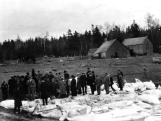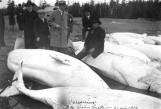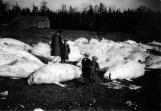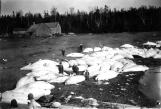1
On May 21, 1929, during a single tide, the Lizottes witnessed an exceptional event. A total of 107 belugas were caught in their fishing ground. Passers-by and key figures came to see the white belugas roped up on the beach. Journalists rushed in to report on the story; the little town's beluga fishery made headlines and became the subject of articles, notably in National Geographic Magazine.It is easy to imagine all the excitement and work generated by this fishery. It is not known whether more than the usual six men were involved in retrieving the cetaceans, cutting them up, melting their blubber and preparing the skins. It is, however, known that blubber was melted for 18 days straight, and that 10,000 gallons of oil were produced.
Inevitably, not all captured belugas were processed. The quantity of the catch, combined with the time required for processing, resulted in losses. The carcasses began to decompose. Émile Lizotte told his son, Georges-Henri Lizotte, that the odour of the rotting carcasses could be smelled as far away as the town of Rivière-Ouelle and for miles around.
Since the very first fishery in 1698, the number of belugas caught fluctuated. Good years were always interspersed with bad. This was the result of fluctuations in the beluga populations; the same was true of populations of commercial fish such as cod and salmon. The reasons for this variation in the quantity of fish caught was not documented at the time, much less understood by fishermen and government officials.
2
Gathering during the extraordinary catch of 192921 May 1929
Pointe de la Rivière Ouelle, Rivière-Ouelle, Quebec, Canada
 Credits:
Credits:Centre d'archives de la Côte-du-Sud
Collège de Sainte-Anne-de-la-Pocatière collection (F100/728/10/15)
Unknown photographer
Émile Lizotte (1902?1988)
3
Dignitaries and Joseph Lizotte Sr., during the extraordinary catch of May 192921 May 1929
Pointe de la Rivière Ouelle, Rivière-Ouelle, Quebec, Canada
 Credits:
Credits:Centre d'archives de la Côte-du-Sud
Collège de Sainte-Anne-de-la-Pocatière collection (F100/728/10/10)
Unknown photographer
4
Children among belugas during the extraordinary catch of May 192921 May 1929
Pointe de la Rivière Ouelle, Rivière-Ouelle, Quebec, Canada
 Credits:
Credits:Centre d'archives de la Côte-du-Sud
Collège de Sainte-Anne-de-la-Pocatière collection (F100/728/10/12)
Photograph: Arthur Gendreau
5
Extraordinary catch of May 192921 May 1929
Pointe de la Rivière Ouelle, Rivière-Ouelle, Quebec, Canada
 Credits:
Credits:Centre d'archives de la Côte-du-Sud
Collège de Sainte-Anne-de-la-Pocatière collection (F100/728/10/15)
Photograph: Arthur Gendreau
6
Postcard of the extraordinary catch of May 192921 May 1929
Pointe de la Rivière Ouelle, Rivière-Ouelle, Quebec, Canada
 Credits:
Credits:Photograph: Mrs. Napoléon Gagnon
J.B. Plourde, publisher
7
Back of the postcard for the extraordinary catch21 May 1929
Pointe de la Rivière Ouelle, Rivière-Ouelle, Quebec, Canada
 Credits:
Credits:Photograph: Mrs. Napoléon Gagnon
J.B. Plourde, publisher
8
Beluga cemetery, skulls from the extraordinary catch of 1929Around 1930
Pointe de la Rivière Ouelle, Rivière-Ouelle, Quebec, Canada
 Credits:
Credits:Vladykov, Vadim-D. "Études sur les mammifères aquatiques." Montreal, Université de Montréal, 1944
Unknown photographer
9
Beach where the belugas were hauled to be cut up18 October 2008
Pointe de la Rivière Ouelle, Rivière-Ouelle, Quebec, Canada
 Credits:
Credits:Photograph: Judith Douville
10
Émile Lizotte working at his eel fishery1960s
Pointe de la Rivière Ouelle, Rivière-Ouelle, Quebec, Canada
 Credits:
Credits:Photograph, around 1960: Unknown
2009 photograph: Guy Duguay